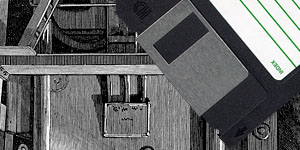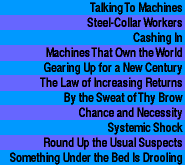


Chance and Necessity
New technology always has consequences. Take the car's influence on America, for example. In 1890, America had a few dozen cars, less than two hundred kilometers of paved roadway, and over three million blacksmiths, coachmen, saddlers, hostlers, and whatnot. One in every twenty Americans earned a living from over eighteen million horses and mules.A century later, all those jobs had gone away, living on only in family names like Smith, Waggoner, Ostler, and Wainwright. Today, 91 percent of all American households have at least one car, and almost every adult American is a driver. Worldwide, there are about five hundred million motor vehicles---a third of them in North America---and over fifty million more are added every year. America alone makes over seven million of these new cars annually. Even with Japanese and European competition, automotive and related industries still generate one in twelve American manufacturing jobs.
Of course, many of the changes brought about by the automobile were simply cosmetic. Cars as status symbols are no different from carriages as status symbols, and cars as tokens of virility are the modern-day equivalent of a spirited horse. Cars replaced horses in Hollywood chase scenes, but the good guys still cut the bad guys off at the pass. And they still wear white hats.
Other changes had deeper and wider consequences that we don't fully understand, even today. For example, rising mobility must have caused large-scale genetic changes as more Americans started marrying people outside the local gene pool. Thanks to the car, the state fair was as close as the county fair. Having their own transport also freed farmers from dependence on common carriers; and the ability to truck their own produce to market changed land values as previously unreachable areas suddenly became accessible. This, in turn, increased land speculation and stock market activity and decreased the price of goods.
Between 1910 and 1960, thanks to tractors alone, the effort needed to produce a bale of cotton dropped by a factor of four; for a bushel of corn or wheat, the change was a factor of six. In 1942, no American cotton was harvested mechanically; by 1972, all of it was picked by machine. That one change alone drove millions of poor, uneducated---and mostly black---Americans from the southern countryside. Huge social changes followed. And still follow.
The car made cities more accessible, which made them more populous, which made their outskirts more desirable. Suburbs exploded, and farms were abandoned, leading to urban sprawl and farm subsidies. Big combines ate up small farms, and the grapes of wrath flowed to California. Within a single generation, the combustion engine let Americans travel ten times farther than they had before. Then it gave America flight. Proliferation of the automobile led to massive roadworks; the demise of rail and horse transport; a jump in mining, metal work, oil exploration and use; and, in the fullness of time, perhaps, to the 1991 Gulf War.
The car increased the supply of fresh food available in big cities and decentralized shopping. It also became the single largest cause of untimely death; each American presently has a one-in-seventy-five chance of being killed in or by a car. Being able to jump in a car and roar off also increased interstate crime, which (along with Prohibition) forced the government to establish the Federal Bureau of Investigation.
On and on the changes went. The car led to increases in wages, education, and the size of the middle class. It helped bring about greater uniformity of opinion, major shifts in voting patterns and issues, changes in social and sexual mores, increases in pollution, noise, and congestion. Everything from small-town ignorance to big city violence, traffic jams, tourism, trade and transportation unions, and changes in fashion was affected by the automobile---or blamed on it.
All that happened because of the Model T and its descendants. And, despite the computer industry's many boasts, the Model T of computers has yet to be developed. That will only happen when computers grow powerful enough and cheap enough for us to talk to them and for most of us to both buy and use them comfortably. Which should take another two decades.
Of course, in the car's early days, experts said it would never replace horses; having no brain, it was clearly inferior. Farmers stoned the rattling vehicles; the clergy fulminated against the devilish invention; and newspaper editors simply laughed at it. Cars, they argued, would not catch on, because Americans would never get used to speeding along behind nothing. Everyone pushed for laws severely restricting when and how cars could move. Politicians, ever keenly aware of their best interests, passed numerous horse laws---the horse vote was far more important than the car vote.
In his 1934 novel Cranks, Nobel laureate Luigi Pirandello wrote: "This is the triumph of folly. So much genius and so much zeal is devoted to the creation of this monstrous thing, which ought to remain a tool, but instead becomes our master. The machine, which knows no rest, will swallow up our life and soul." In time, of course, the wrath died, although hostility against the automobile remained until well into the 1940s. And the changes it brought continue to this day.
Resistance to technological change has happened before---and will happen again. We smashed printing presses when they were new, and mechanical looms when they were new. We called the first steam engines an invention of the devil and knew with certainty that steel ships would sink. We spread soft soap on railway lines to stop the first trains and flung broken glass to stop the first cars. We thought evil spirits lived in the first telephones because they appeared to talk for themselves and television, we contended, would never catch on; the first sets were too fragile, too expensive, too hot, unreliable, and dangerous. We laughed at bicycles and tractors, and we raged at sewing machines and refrigerators. Nobody---not the crazy inventors, not the knee-jerk conservatives---had any real idea where the choices opened up by a new technology---whether plow, car, or computer---would lead. In fact, the radical changes brought about by cars alone make even the most outlandish science fiction laughable. It simply isn't imaginative enough.